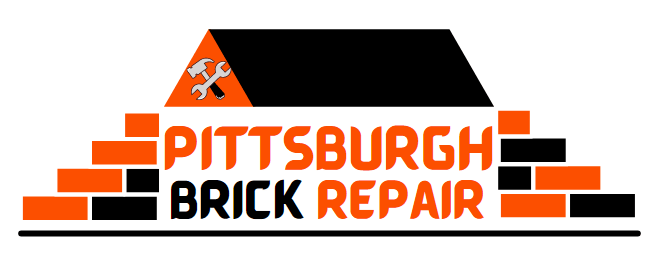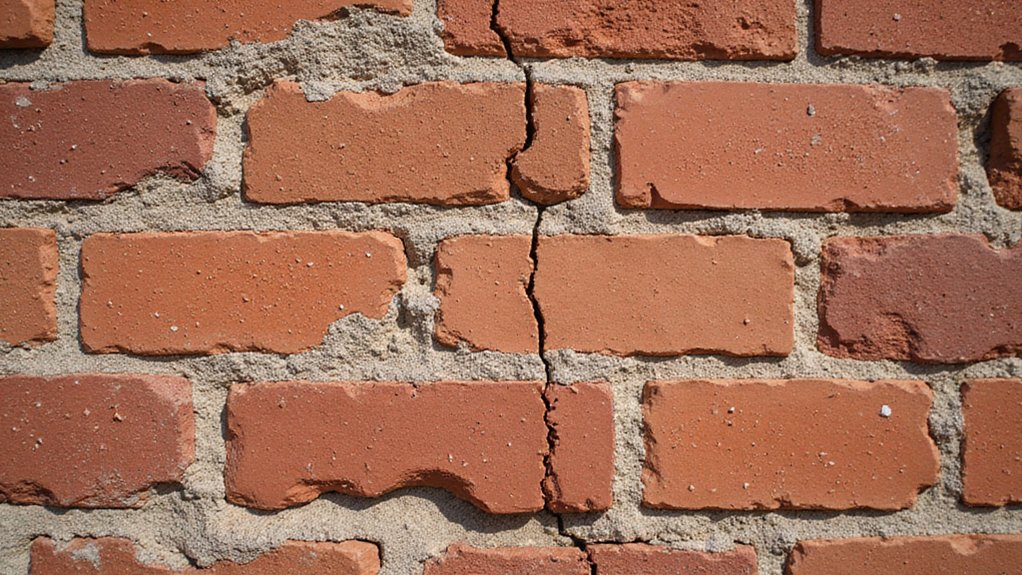Brick wall cracks can be more than just cosmetic concerns—they’re potential warning signs of underlying structural issues. You might think those tiny fissures are harmless, but they could be silently telling a story about your home’s foundation and stability. While some cracks are normal, others demand immediate attention. Before you dismiss that small crack, there’s critical information you need to know that could save you thousands in future repairs.
Types of Brick Wall Cracks and Their Characteristics
When it comes to brick walls, not all cracks are created equal. Different brick bonding patterns can influence how and where cracks develop, making some more weighty than others. Thermal expansion effects can cause hairline fractures that might seem minor but could indicate underlying structural issues. Vertical cracks are often less concerning than horizontal or stair-step cracks, which might signal serious foundation problems. Understand that small, thin cracks running along mortar joints could be normal settling, while wider, deeper cracks might demand professional inspection. Your wall’s age, construction method, and environmental conditions all play essential roles in crack formation. Tuckpointing services can help address mortar deterioration before it leads to more significant structural damage.
Common Causes of Brick Wall Cracking
Why do brick walls develop cracks that can worry homeowners? Environmental factors play a significant role in wall damage. Freeze thaw cycles, where water expands and contracts within brick structures, create consistent stress that leads to small fractures. Tuckpointing services can help prevent long-term damage by addressing mortar deterioration before it compromises the entire wall structure.
Temperature fluctuations, soil movement, and moisture exposure can gradually weaken your wall’s structural integrity. Foundation settlement, improper construction techniques, and natural aging also contribute to brick wall cracking. Understanding these causes helps you identify potential risks and take proactive maintenance steps. By recognizing the underlying reasons, you’ll be better equipped to address and prevent further wall damage.
When to Worry: Red Flags of Structural Damage
Some brick wall cracks can signal serious structural problems that’ll compromise your home’s safety and value. You’ll want to watch for specific warning signs that indicate potential structural weaknesses.
Horizontal or diagonal cracks wider than ¼ inch, especially near windows and doors, suggest significant foundation movement. Stair-step cracks in masonry walls can reveal serious settling issues that might dramatically impact home value.
If you notice cracks accompanied by bulging walls, uneven floors, or doors that won’t close properly, it’s time to consult a professional structural engineer who can assess the damage.
DIY Assessment of Brick Wall Cracks
Although brick wall cracks might seem intimidating, homeowners can perform a preliminary assessment to understand potential risks. You’ll want to start with visual inspection techniques, carefully examining crack patterns, width, and location.
Look for horizontal, vertical, or diagonal cracks, noting their size and progression. Use moisture detection methods to check for water damage around cracks, which could indicate deeper structural issues. Don’t panic, but stay observant. Measure crack widths periodically and document changes. If you notice significant growth or concerning patterns, it’s time to consult a professional who can provide expert evaluation and peace of mind.
Professional Inspection: What to Expect
How can you guarantee a thorough professional brick wall examination? You’ll want to hire a certified structural engineer or experienced masonry professional who specializes in brick wall inspection. They’ll undertake a comprehensive assessment, carefully measuring crack width, depth, and pattern while evaluating potential underlying structural issues.
A qualified professional opinion will help you understand whether those small cracks are merely cosmetic or signal more serious problems. They’ll use specialized tools to assess wall stability, providing detailed documentation and recommendations. By investing in a professional inspection, you’re protecting your property and gaining peace of mind about your home’s structural integrity.
Repair Methods for Different Crack Severities
Most brick wall cracks demand specific repair techniques customized to their severity and underlying causes. Hairline cracks might require simple moisture sealing techniques that prevent water infiltration and further damage.
For slightly wider cracks, you’ll want professional repointing procedures where damaged mortar is carefully removed and replaced with fresh material. Wider structural cracks typically need more extensive interventions, such as professional masonry repairs or potential foundation assessments.
Your approach depends on the crack’s width, location, and potential risk to your home’s structural integrity. Understanding these intricate repair methods can help you protect your property effectively.
Preventative Measures to Minimize Wall Cracking
Protecting your brick walls from cracking starts with proactive maintenance and strategic home care strategies. By implementing preventative measures, you’ll safeguard your home’s structural integrity and avoid costly repairs.
Consider these essential steps:
- Perform periodic mortar inspections annually
- Monitor foundation drainage and grading
- Manage moisture around your home’s exterior
- Control soil expansion and contraction
- Implement proactive crack monitoring techniques
Your commitment to consistent maintenance will help minimize potential wall damage. Regular attention and early intervention can prevent small cracks from becoming significant structural issues, ensuring your home remains strong and stable for years to come.
Cost Implications of Ignoring Brick Wall Cracks
Because small brick wall cracks might seem insignificant, homeowners often underestimate the potential financial consequences of ignoring them. The financial impact of delayed repairs can quickly escalate from minor expenses to major reconstruction costs.
What starts as a small, inexpensive fix could transform into a significant structural issue requiring thousands of dollars in extensive repairs. Long-term cost considerations reveal that timely maintenance is far more economical than postponing necessary interventions.
Frequently Asked Questions
Can Humidity Levels Affect Brick Wall Cracking?
You’ll find that humidity and moisture buildup can definitely cause brick wall cracks, especially when temperature fluctuations expand and contract building materials, leading to structural stress.
Do Tree Roots Near My House Cause Wall Damage?
Tree roots can destabilize your soil moisture levels, threatening your brick wall stability. They’ll gradually expand, causing pressure that can crack and shift your foundation, potentially compromising your home’s structural integrity.
How Quickly Can Small Cracks Become Major Structural Problems?
You’ll want a structural integrity assessment to track crack propagation swiftly. Small issues can escalate within months, potentially compromising your home’s stability if left unchecked by professionals.
Are Older Homes More Prone to Brick Wall Cracks?
You’ll find older homes are more susceptible to brick wall cracks due to seasonal temperature fluctuations and potential improper masonry installation, which can compromise your home’s structural integrity over time.
Will Homeowners Insurance Cover Brick Wall Crack Repairs?
Your homeowners insurance might cover brick wall cracks, but you’ll need to check your policy limits and weigh repair cost considerations. Coverage depends on the crack’s cause and your specific plan.

